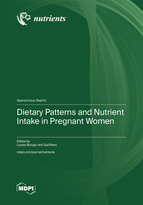Dietary Patterns and Nutrient Intake in Pregnant Women
A special issue of Nutrients (ISSN 2072-6643). This special issue belongs to the section "Nutrition in Women".
Deadline for manuscript submissions: closed (20 April 2023) | Viewed by 34923
Special Issue Editors
Interests: iodine; thyroid; micronutrients; pregnancy; breastfeeding; infancy
Special Issues, Collections and Topics in MDPI journals
Interests: dietary interventions to improve nutrition in women during pregnancy and in young children; management of obesity during pregnancy and childhood; micronutrient status in women and children
Special Issues, Collections and Topics in MDPI journals
Special Issue Information
Dear Colleagues,
Optimum nutrition in pregnancy is important for the health and wellbeing of the mother and the developing child. Nutrition at this time influences the physiological development and metabolism of the foetus and has the potential to determine the future health and disease risk of the offspring. Nutritional status during pregnancy also influences the mother’s breast milk, her nutritional status for future pregnancies, and impacts on the burden of chronic disease worldwide. Determining optimal nutrition for different stages of pregnancy and measuring nutrient intake is challenging. Across the world and within communities, different dietary patterns have been identified, and linked to health outcomes. Dietary patterns, rather than individual food constituents and nutrients, may have a greater influence on health. This Special Issue seeks to bring together global research on dietary patterns and nutrient intakes during pregnancy to further our understanding of the influence of diet on maternal and foetal/infant outcomes.
Dr. Louise Brough
Dr. Gail Rees
Guest Editors
Manuscript Submission Information
Manuscripts should be submitted online at www.mdpi.com by registering and logging in to this website. Once you are registered, click here to go to the submission form. Manuscripts can be submitted until the deadline. All submissions that pass pre-check are peer-reviewed. Accepted papers will be published continuously in the journal (as soon as accepted) and will be listed together on the special issue website. Research articles, review articles as well as short communications are invited. For planned papers, a title and short abstract (about 100 words) can be sent to the Editorial Office for announcement on this website.
Submitted manuscripts should not have been published previously, nor be under consideration for publication elsewhere (except conference proceedings papers). All manuscripts are thoroughly refereed through a single-blind peer-review process. A guide for authors and other relevant information for submission of manuscripts is available on the Instructions for Authors page. Nutrients is an international peer-reviewed open access semimonthly journal published by MDPI.
Please visit the Instructions for Authors page before submitting a manuscript. The Article Processing Charge (APC) for publication in this open access journal is 2900 CHF (Swiss Francs). Submitted papers should be well formatted and use good English. Authors may use MDPI's English editing service prior to publication or during author revisions.
Keywords
- dietary patterns
- nutrition
- nutrient intake
- pregnancy
- dietary intake








